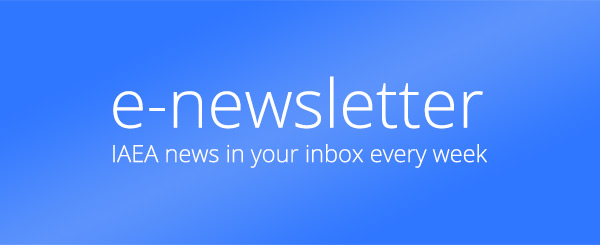Looking back on 2008, the IAEA´s future drew close attention, alongside some longstanding dynamic nuclear issues. Below are selected highlights from January to December 2008, from the pages of IAEA.org.
January 2008
- The US Congress allocates $50 million toward creation of a international nuclear fuel bank under the auspices of the IAEA.
- An IAEA delegation headed by Director General ElBaradei visits Iran for talks on the implementation of nuclear safeguards.
February
- An IAEA team assists Nigerian authorities to recover stray radiation sources in three locations around the country.
- A follow-up report underlines nuclear safety issues arising from the July 2007 earthquake in Japan that led to the shutdown of the Kashiwazaki-Kariwa nuclear power plant.
- More atomic sleuths - scientists with expertise in what´s known as nuclear forensics - are needed to reinforce the world´s nuclear security, IAEA officials and scientists report.
March
- Feature stories highlight lessons from the tragic 1987 Goiânia accident in Brazil, which alerted the world to the dangers of abandoned radiation sources and led to strengthened international safety standards.
- IAEA Director General ElBaradei reports to the Agency´s Board of Governors on nuclear safeguards in Iran, including the status of outstanding issues.
- Russia´s radiation legacy draws the attention of emergency-response teams in Murmansk, the site of aging Soviet-era nuclear submarines and stored nuclear waste.
April
- A high-level review panel assessing the IAEA´s future receives a background report on Agency programmes and priorities to the year 2020.
- More than 500 delegates from 61 countries conclude an extensive peer review on the safety of nuclear power plants.
- Kenya´s progress in applying nuclear techniques for developing new and hardier varieties of wheat is feeding its goals of food security.
May
- Delays and denials of shipments involving regulated radioactive materials used in medicine and industry are of growing concern to safety and industry experts.
- Tanzania´s cancer institute receives a new radiotherapy machine through the IAEA´s Programme of Action for Cancer Therapy (PACT), to help treat the country´s rising number of cancer patients.
- The United States ratifies a key treaty that governs global civil nuclear liability in the event of a nuclear accident.
- IAEA-supported research finds that patients in developing countries often need to have X-ray examinations repeated so that doctors have the image quality they need for useful medical diagnosis.
June
- Studies report that uranium resources are adequate to supply the fuel needs of nuclear power plants for the rest of the century - at present consumption levels.
- The IAEA´s future is clouded by political and financial issues influencing its global roles, reports the high-level panel assessing the Agency´s future to 2020.
- At a time of rising interest in nuclear electricity generation, the Republic of Korea marks 30 years of nuclear power development.
- IAEA-supported training and equipment help China recover radioactive sources lost in the debris of an earthquake.
July
- Specialists from seven countries in Africa are trained to improve control of radiation sources at a workshop in Morocco.
- Vietnam´s battle to help cancer patients gains valuable ground through the IAEA-supported PACT partnership.
- The IAEA works to raise awareness of radiation risks to heart surgeons from medical uses of X-ray imaging systems.
August
- The IAEA Board approves a new safeguards agreement with India covering the country´s civilian nuclear facilities.
- China and the IAEA work closely as part of overall security preparations for the Olympic Games, opening this month in Beijing.
- The IAEA projects a steady increase in the nuclear generation of electricity over the next decades, reflecting expansion plans in Asia and other parts of the world.
September
- In a joint project with the European Space Agency, the IAEA studies the use of satellite networks for monitoring nuclear installations and materials under international safeguards.
- The IAEA releases updated data on illicit nuclear trafficking incidents confirmed since December 1993.
- Delegates from more than 100 countries face far-reaching decisions in Vienna on nuclear issues and the IAEA´s work at the annual General Conference.
- The World Nuclear Security Institute is launched in Vienna.
- The IAEA´s future to the year 2020 is examined in the context of recommendations issued by a high-level panel that call for greater funding and legal authority for the Agency.
October
- The process of appointing the IAEA Director General for four years beginning 1 December 2009 begins.
- A successful "Atoms for Food" partnership of the IAEA and Food and Agriculture Organization (FAO) stands in the balance.
- A new diagnostic kit is announced to help revolutionize the global fight against the feared "bird flu" virus and other such diseases.
- World health and safety experts meet in Buenos Aires at the International Congress on Radiation Protection.
November
- Potential nuclear "newcomers" join experienced nuclear operators at an international conference in India on topical issues of nuclear plant safety.
- The IAEA Board moves to conclude November meetings, taking decisions related to nuclear safeguards, technical cooperation, and nuclear safety.
- Issues of global warming and nuclear power draw close attention in Poland, at the UN Climate Change Conference.
December 2008
- The IAEA calls for increased investment in a plant breeding technique that could bolster efforts aimed at pulling millions of people out of the hunger trap.
- The European Union (EU) pledges Euro 25 million ($32 million) towards the nuclear fuel bank proposed for placement under IAEA auspices.
- Young professionals are selected for the next class of the World Nuclear University, set to take place at the University of Oxford in England in summer 2009.
- The IAEA marks the 50th anniversary of its extensive standards for nuclear and radiation safety, which today number more than 200 and underpin international legal conventions in the nuclear field.
For a fuller review of 2008 and previous years, see IAEA.org and the Frontpage archives. For a look ahead, see the latest news stories and upcoming events.


